
Framing Up for “Flowers”
Marcell Rév, ASC, HCA channels classic Hollywood glamor in this Miley Cyrus music video.
Cinematographer Marcell Rév, ASC, HCA was nominated for a 2023 MTV Video Music Award for Best Cinematography for his work on Miley Cyrus’ “Flowers,” based on the track from her album Endless Summer Vacation. The music video marked his second collaboration with the singer and director Jacob Bixenman, following his work on the TV special Miley Cyrus: Endless Summer Vacation (Backyard Sessions). Rév has gone on to photograph the video for her song “Used to Be Young,” from the same album.
Rév loves the challenge of music videos and other short-form projects: “You have to build a complete detailed world in a brief amount of time. Even if it’s three shots, or a oner, you have to build a world around it and that takes almost the same amount of work that it does for a movie. You have less time to talk to the director about what they want to do, so it’s always a fast-paced process. I love that it’s quick and you get to shoot it in a week or two — you see the results so soon.”
When Bixenman, Cyrus’ creative director, reached out to Rév about the Flowers music video, the cinematographer was working in Europe. With only a few weeks of prep, he emphasizes the importance of having a shorthand with your collaborators, explaining, “When I work with a director the second, third, fourth time, it’s always better because I already know their vision and we don’t have to start from scratch. That’s really helpful in short form. Having the trust and already understanding what the artist is going for is also great. Obviously, Miley had a vision for what she wanted for this, and, at the end of the day, it’s about her and her song. Knowing her and what she likes was helpful.”
Bixenman and Rév decided on a simple, intimate approach to the Flowers video. With lyrics emphasizing inner empowerment and the ability to treat yourself better than an ex-lover might, the song calls for a special focus on Cyrus. The video leans into this, focusing solely on the pop star as she walks up a winding road in the Hollywood hills to a luxury home with views over downtown Los Angeles. She is clad in a metallic vintage Yves Saint Laurent gown, sunlight sparkling off her, demanding attention. As she spends the day enjoying time to herself, dancing, swimming, and working out, the camera stays with her in a widescreen frame. The clip ends with her dancing on the roof, brilliant spotlights circling as if police helicopters are flying above — suggesting her day trip was in fact a stolen moment.
“We wanted a feeling of simplicity, and also that the audience would feel like they were there. There was a reference to 1950s Hollywood glamor, and that resulted in using vintage-style anamorphic lenses and informed the locations we picked.”
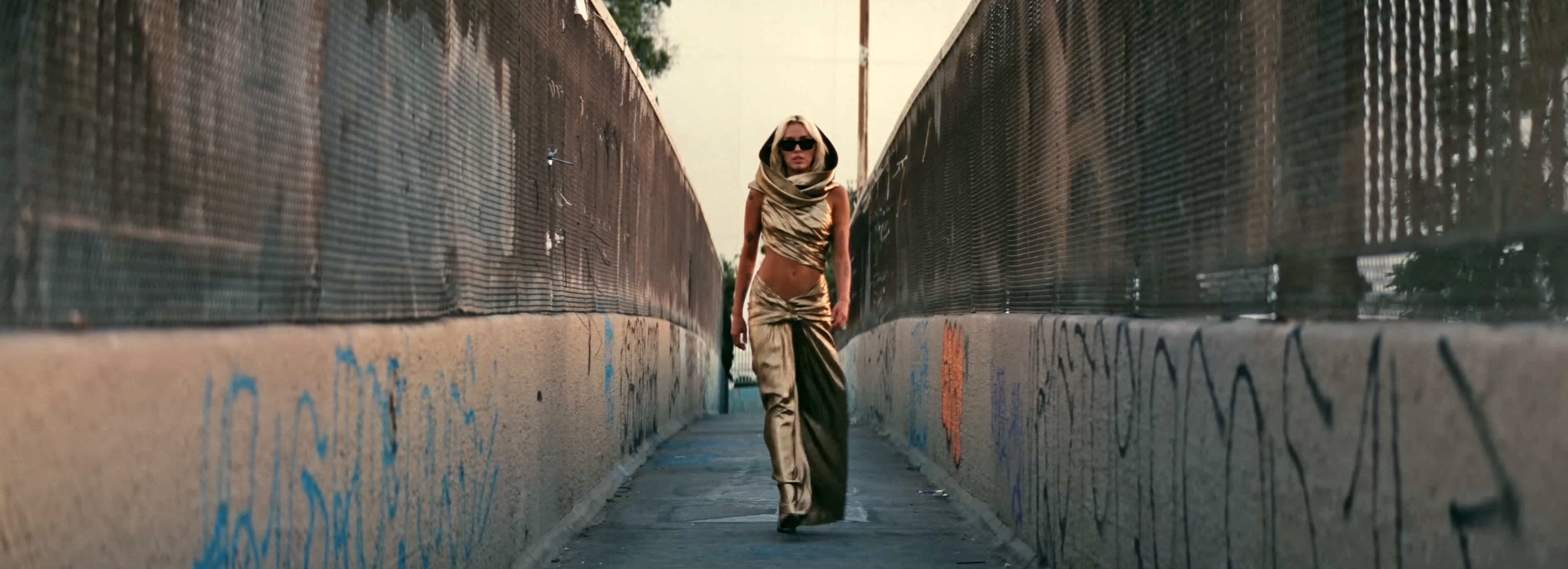

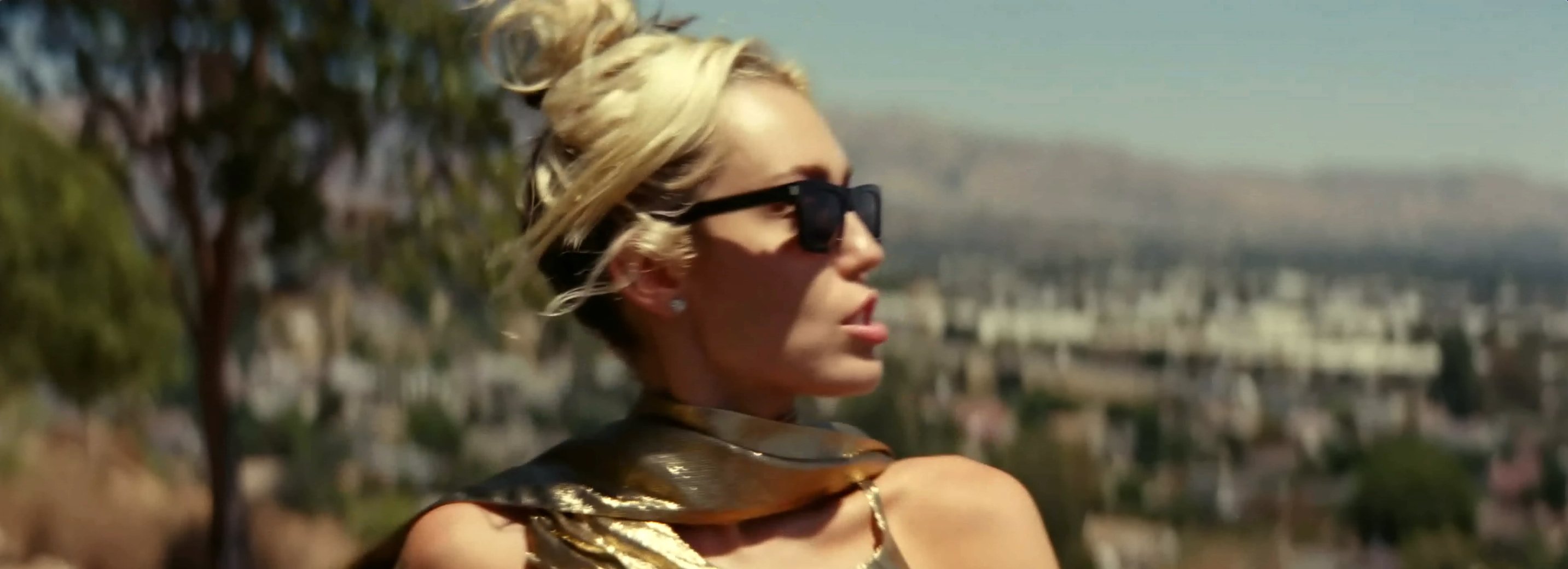
Cyrus is the only character that appears in the video and there’s no apparent plot set out by the visuals. Rév admits, “We had this idea that it was a woman intruding into someone else’s home. She has a fantasy of being in her own home. It isn’t in the story, but that’s what we were thinking.
“We wanted a feeling of simplicity, and also that the audience would feel like they were there. There was a reference to 1950s Hollywood glamor, and that resulted in using vintage-style anamorphic lenses and informed the locations we picked.”
The video was filmed at the historic Farralone House, a Midcentury Modern icon located in LA-adjacent Chatsworth designed by architect William Pereira — which had been Frank Sinatra’s residence for 10 years. Rév is effusive about the home as a filming location: “With this house, you can really photograph the view from the inside. You can have a scene in the living room and still see the hills around LA.” The cinematographer made use of the architecture throughout the video, highlighting the views as Cyrus dances around the location.
Shooting on 35mm film, Rév paired an Arricam LT with Atlas Orion lenses. The versatility of the Arricam allowed for handheld work, while the Orions, a modern set of anamorphics, “still had the feel of older glass. It wasn’t too funky, which I liked because I didn't want to overdo the effect.” Rev further added to the vintage look by utilizing a set of custom black net filters that softened the image in the darker tones.
There was never a discussion about shooting digitally. From the beginning, Bixenman and Rév’s vision was to shoot on film. Rev admits, “I just like the medium better than digital. I think it speaks to you somehow. It feels more honest, warmer, more organic. It’s just my go-to. Usually, it’s not even a question for me to shoot film.” Flowers was colored at Company 3 by Rév’s longtime collaborator, chief creative officer and senior colorist Tom Poole.
Shooting on film added to the Hollywood glamor effect that Bixenman and Rév sought. “I wanted to make it look like it has a heightened reality to it,” the cinematographer says, “with vivid colors and a lot of gold and yellowish tones to it. I had one movie in mind: American Hustle by [director] David O. Russell. It had something to do with it, not on a technical level, but just the feeling of it.” The 2013 feature, shot by Linus Sandgren, ASC, FSF, was also captured on 35mm film (see AC Jan 2014).
“The small details can create a mood. When we discovered on the scout that there is a [patio shade] that can create striped lighting through this wood, it just created the whole visual mood for the workout sequence.”
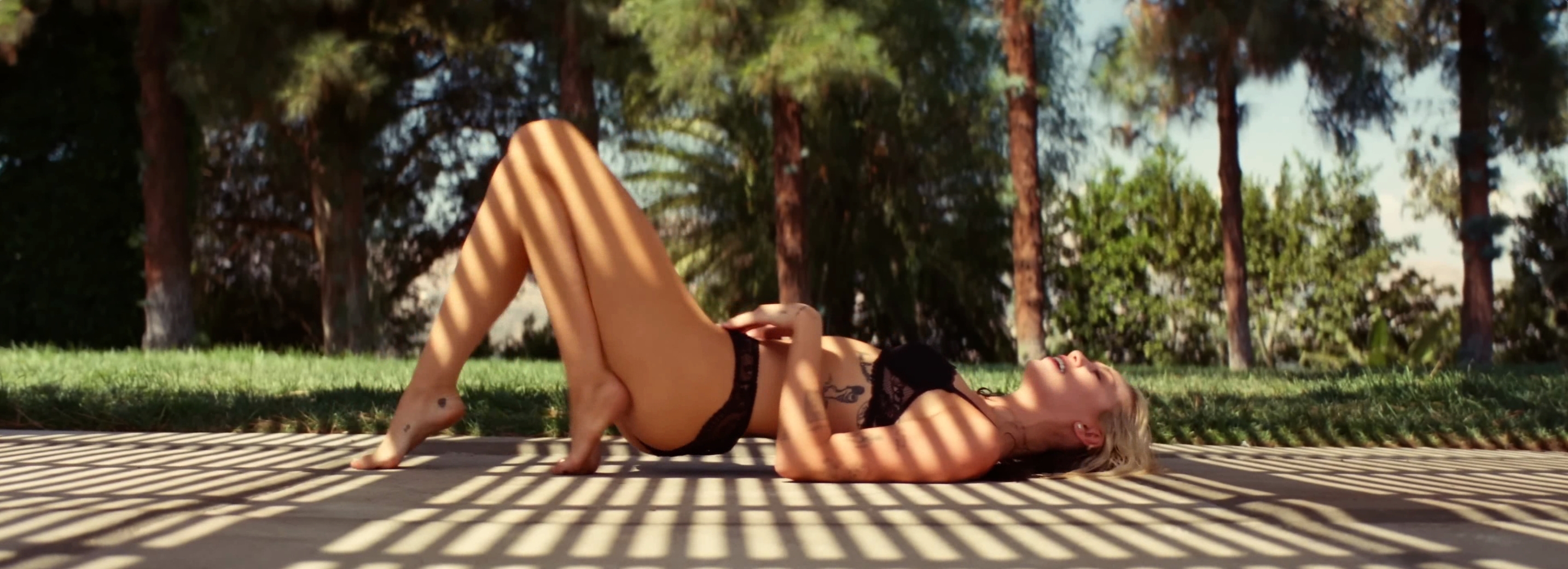
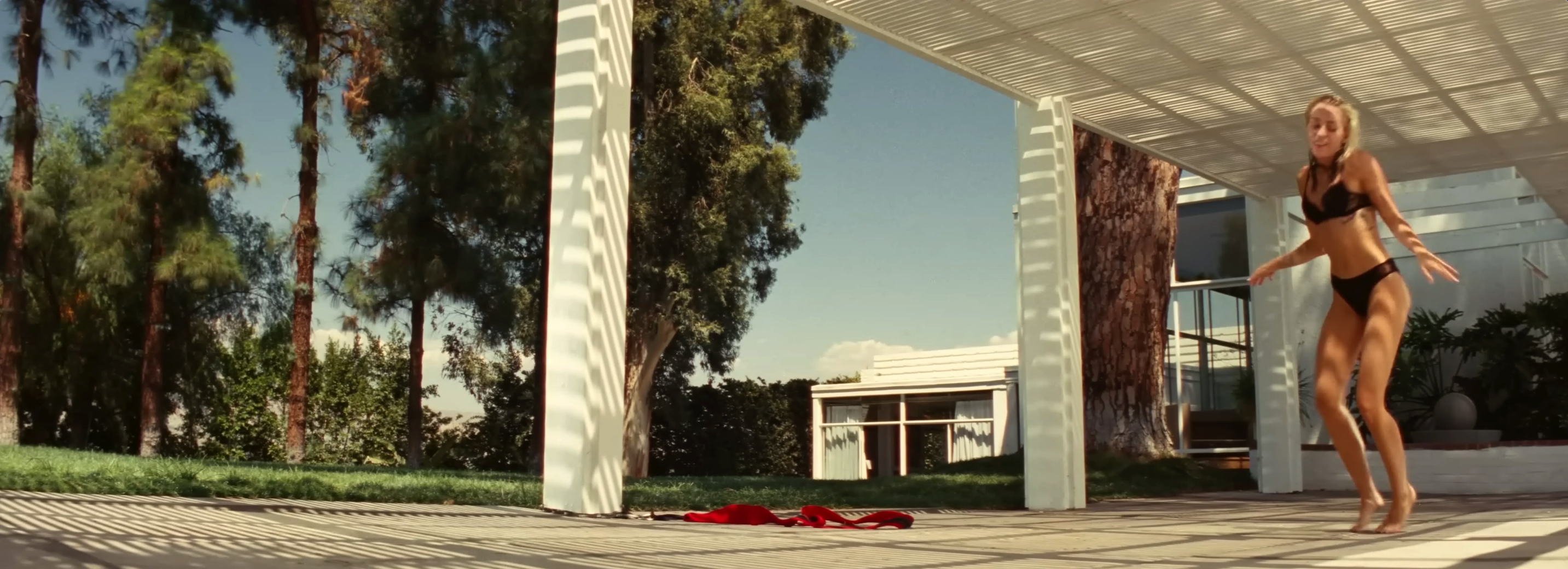
Much of the daylight scenes relied on natural light, augmented only as much as was necessary for exposure levels on the Eastman Kodak Vision3 5207 250D negative. The only scene that leaned into a more “lit” feeling was the workout sequence: “I wanted to make it a little harsher, a little heavier, a little more poppy. There we used some edge lights to make it glitter a little and shine.”
Yet even for these shots, natural sunlight was still key: “The small details can create a mood. When we discovered on the scout that there is a [patio shade] that can create striped lighting through this wood, it just created the whole visual mood for the workout sequence. Those tiny things in a video like this can make a scene. We planned our days around that lighting. It was a two-day shoot and we planned our days so we could get there by the time the sun hit that angle.” The combination of natural lighting and harder edge light allowed the cinematographer to create a stark, heightened look with hard, graphic shadows cutting across Cyrus’ physique.



Rév manipulated the color tonality of the film more for the evening and night work. “Some of the dusk shots are [Vision3 5219] 500T, he says. “It brings a certain touch and an interesting tonality to the skin tones. I usually don’t filter it. What they suggest is to use an 85 filter, which is an orange filter, to balance your tungsten stock to daylight, but I usually do that in post to keep that cyan tone. I like it.” This is his usual approach to shooting with tungsten stock in daylight settings, something that he has worked on with Poole before many times.
The night scenes created the biggest technical challenge on the shoot. The house is positioned on a steep hill, which required ingenuity to be lit from above to simulate helicopter spotlights. Rév credits his crew working quickly and efficiently, “There was no rehearsal day and we had to get it right on the day.”

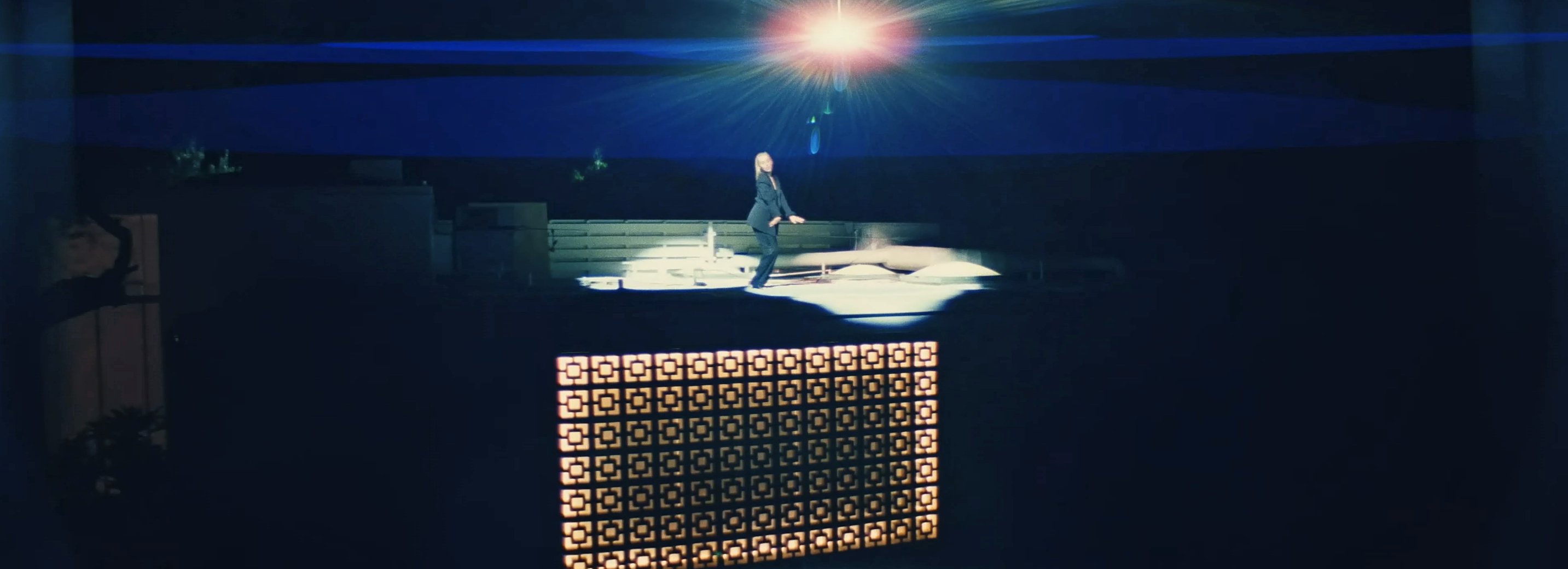

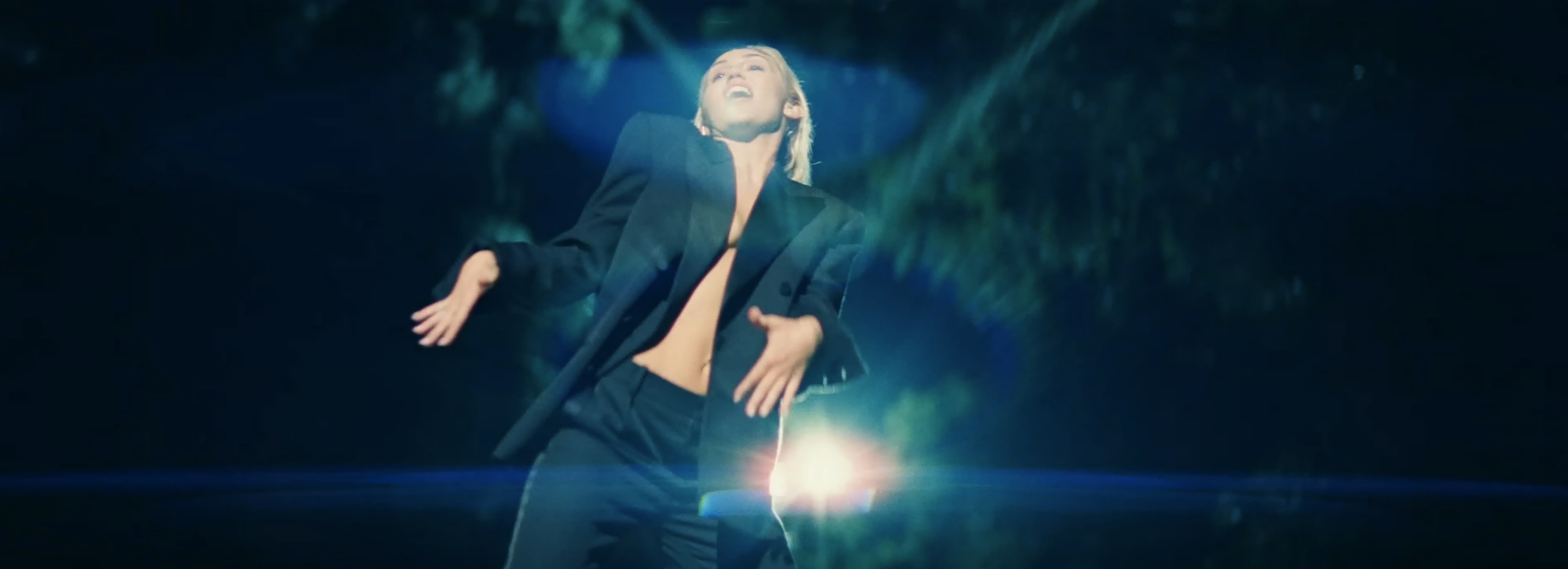
In the end, the cinematographer was happy with the finished look of the sequence: “We wanted the feeling of multiple helicopters circling the house. We used HMIs and big daylight-balanced Xenon movers. They have a cyan tint to them and were rigged on construction cranes. The house is on a hill, so we had to get over it with the cranes, which was the trickiest part. I had a crane to operate from to get above her and to create the feeling of filming from a helicopter.”
While Rév emphasizes the simplicity of the music video, the two-day schedule required everything to be executed perfectly the first time around. Looking back at the project, he’s excited to see how the minutiae combined to result in the overall visual style he was striving for: “I love getting a sense of how small details can create a mood. Discovering a beautiful view on the road up to the house that can visually define a scene. It’s those tiny things that really, in a video like this, create a scene.”






